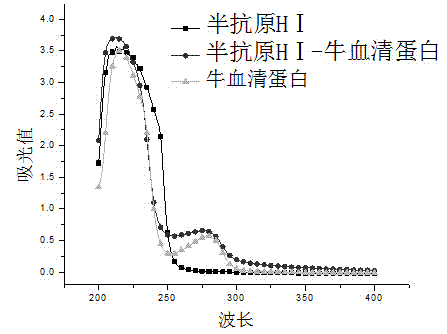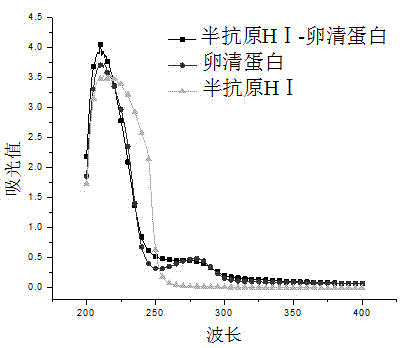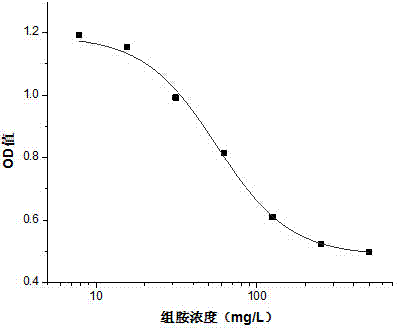Semi-antigen, artificial antigen, and antibody aiming directly at histamine, preparation method and applications thereof
A technology of artificial antigen and hapten, which is applied in the field of hapten directly targeting histamine, antibody and its preparation, and artificial antigen, to achieve the effect of strengthening the immunogen stress response, eliminating the derivation step, and improving the detection sensitivity and specificity
- Summary
- Abstract
- Description
- Claims
- Application Information
AI Technical Summary
Problems solved by technology
Method used
Image
Examples
Embodiment 1
[0049] The preparation method of embodiment 1 hapten HI (n=0)
[0050] Add 0.92 g (5 mmoL) histamine dihydrochloride to a 50 mL round bottom flask, and slowly add methanol until dissolved, then add 0.54 g (10 mmoL) sodium methoxide, and add 0.75 g p-formylbenzoic acid ( 5 mmoL), stirred at room temperature for 1 hour, added 0.37 g (10 mmoL) of sodium borohydride, and continued to react for 0.5 hours. The product was dissolved in ethanol and kept overnight in a refrigerator at 4°C. Crystals were precipitated, filtered, washed twice with cold ethanol, and dried to obtain 0.84 g of white crystals, which were haptens, with a yield of (69.4%). ESI-MS analysis (positive) m / z 246 [M+H]+; 1 H NMR (600 MHz, D 2 O) δ = 8.48 (d, J=1.2, 1H), 7.72 (d, J=8.1, 2H), 7.36 (d, J=8.2, 2H), 7.22 (s, 1H), 4.20 (s, 2H) , 3.32 (t, J=7.6, 2H), 3.08 (t, J=7.6, 2H).
Embodiment 2
[0051] Example 2 Preparation of Immunogen / Coating Gen
[0052] In the preparation method of the immunogen and the coating original, the difference lies in the carrier protein used, the immunogen carrier protein adopts bovine serum albumin (BSA), and the coating original carrier protein adopts ovalbumin (OVA ), the coupling method used was the carbodiimide method with certain modifications. The preparation method of the immunogen is used as an example in the following.
[0053] Carbodiimide method: Dissolve 24.6 mg (0.1 mmoL) of the hapten HI (n=0) prepared in Example 1 in 4 mL of boric acid solution (0.1M, pH4.5), stir and add 38.4 mg (0.2 mmoL) 1 -Ethyl-(3-dimethylaminopropyl)carbodiimide hydrochloride (EDC), then add 68mg (0.001mmoL) bovine serum albumin, and react overnight with magnetic stirring at 4°C, keeping the pH at 4.5-5.0 . The mixture after the coupling reaction was dialyzed against normal saline at 4°C for 3 days, and the dialysate was changed 4 times a d...
Embodiment 3
[0055] Example 3 Preparation and identification of antibodies
[0056] Three immunogens with different binding ratios were emulsified with an equal dose of immune adjuvant (Freund's complete adjuvant for the first immunization, and Freund's incomplete adjuvant for subsequent booster immunizations) with a stirrer. After complete emulsification, a 7-week-old Balb / c female mouse was immunized with various immunogens of each combination ratio by subcutaneous injection in the back, subcutaneous injection in various parts, leg muscle, and ear vein. A booster immunization was given 4 weeks after the first immunization, and a booster immunization was given 3 weeks later. One week after the fourth booster immunization, blood was collected from the ear vein, and the serum titer was determined by indirect ELISA. When the titer no longer rises, the ear vein is used to boost the immunization. One week later, the eyeballs were picked for blood collection, and the blood was collected...
PUM
 Login to View More
Login to View More Abstract
Description
Claims
Application Information
 Login to View More
Login to View More - R&D
- Intellectual Property
- Life Sciences
- Materials
- Tech Scout
- Unparalleled Data Quality
- Higher Quality Content
- 60% Fewer Hallucinations
Browse by: Latest US Patents, China's latest patents, Technical Efficacy Thesaurus, Application Domain, Technology Topic, Popular Technical Reports.
© 2025 PatSnap. All rights reserved.Legal|Privacy policy|Modern Slavery Act Transparency Statement|Sitemap|About US| Contact US: help@patsnap.com



